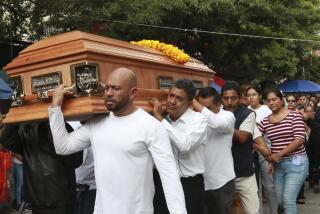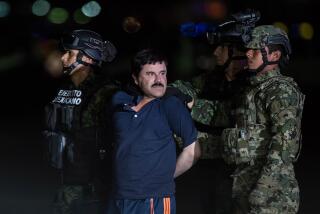Colombian Jungle Base Is Focus of U.S. Anti-Drug Aid
- Share via
TRES ESQUINAS, Colombia — This base in the lush South American jungle is ground zero for President Clinton’s emergency proposal to help fund a massive expansion of Colombia’s anti-narcotics operation.
“This is an island in a sea of guerrillas and narco-traffickers,” U.S. Army Lt. Col. Jan P. Ithier said as he toured the base--where U.S. special forces troops train and monitor the performance of Colombian soldiers--with an American delegation last week.
U.S. and Colombian authorities are now engaged in an elaborate round of salesmanship to promote the $1.6-billion aid package, which Clinton announced last month, to skeptics in both Washington and Bogota, the Colombian capital, who charge that heaps of new money and old aircraft will do little to ease an intractable problem.
Moreover, some fear that despite the United States’ insistence that its soldiers aren’t “advising” the Colombians, only training them, Washington could get sucked into another nation’s civil war.
Billed as a way to reduce the drug production of a country that supplies 80% of the world’s cocaine, the aid package could turn out to be merely “a smoke screen” for fueling Colombia’s 40-year battle against leftist guerrillas, said Winifred Tate, a Colombia specialist at the Washington Office on Latin America, a nonprofit research group.
“This isn’t good drug policy, and it isn’t good human rights policy. I think this is going to make everything much worse,” she said. While the Colombian army’s role in human rights abuses has diminished in the past five years, there is increasing evidence of ties between the military and right-wing private armies that now commit the bulk of violations against civilians.
Colombian President Andres Pastrana is preaching a very different message in Washington this week in meetings with Clinton, congressional leaders and others.
At a speech Wednesday before the U.S. Conference of Mayors, Pastrana said the U.S. can’t afford to turn its back on the problem of rampant drug production in Colombia. In U.S. cities and the Colombian countryside alike, he said, “the stakes are too high.”
U.S. Army Secretary Louis Caldera and Tom Umberg, the deputy of White House drug czar Gen. Barry R. McCaffrey, visited Colombia last week to determine how the money--if approved by Congress--would be spent. Although the Tres Esquinas base is generally off-limits to the media, U.S. officials invited a Los Angeles Times reporter to accompany them on their visit.
Members of the delegation stressed that Colombia has become the glaring weak spot in the U.S. war on drugs.
Although recent increases have made Colombia the No. 3 recipient of U.S. aid--last year, Washington provided $289 million in anti-narcotics assistance--the country’s production of cocaine and heroin has risen sharply in the last few years.
New CIA estimates scheduled for release soon are expected to show that cocaine production is 300% higher than current estimates, officials say.
The U.S. delegation’s trip was aimed chiefly at verifying Colombia’s progress in reining in drug traffickers. But U.S. officials also faced skeptical questioning from Colombian military officers and media in Bogota.
Why, one officer asked Caldera, doesn’t the United States move more aggressively against Colombia’s guerrillas by exposing them for “what they really are”--terrorists?
A local reporter suggested that the United States is filling the aid package with beat-up old Huey helicopters and “just giving whatever you don’t want to Colombia.”
And another reporter wanted to know what assurances the United States had that Colombia’s military and its police force, institutions prone to corruption in the past, would use the new infusion of aid for fighting drugs.
Caldera appeared unfazed. “We trust the Colombian leadership,” he said.
The 60-plus helicopters the Clinton administration wants to give Colombia for anti-narcotics operations include both new and used aircraft, all in fine working order, Caldera said.
“We don’t consider these helicopters to be scraps,” he added.
As for the guerrillas who control large swaths of Colombia’s southern region, Caldera said that the United States wants to pursue anyone supporting the country’s drug trade. With increasing frequency, he said, that includes the guerrillas, who have financed their attacks on government forces by extracting millions in “protection money” from traffickers.
The guerrillas, he said, “made a deal with the devil to run drugs in order to generate resources. . . . Once we control drug trafficking, we’re going to control violence in this country.”
Aiding Pastrana’s administration in the fight against traffickers is “one of the most important things we’re doing here in our own hemisphere,” Caldera said in an interview.
If the United States does nothing to help Colombia wage war against drug producers and traffickers, Caldera said, “you will have a much worse problem five years and 10 years from now.”
Behind-the-scenes differences remain between the U.S. officials and their Colombian counterparts.
U.S. officials, for example, argued that the Colombian police--who, unlike the military, are not known for human rights abuses--must more actively aid the army in anti-narcotics operations, including intelligence gathering and lab work.
During the delegation’s visit to the Tres Esquinas military base, where Colombia’s first anti-narcotics battalion began operations just last month, U.S. officials were irked to see little sign of a police presence.
“Get them down here!” one U.S. official bluntly told the national police chief after touring the base.
At the same time, U.S. officials said the Colombians have improved operations at the base, about 300 miles south of Bogota.
The base is still primitive by U.S. standards, with most of the Colombian soldiers sleeping outdoors on makeshift cots. But an operations center once run from an oversized tent is now in a new warehouse. An underground bunker was built, and a barbed-wire fence is going up on the perimeter, just a few miles from a town that is controlled by the country’s oldest and largest rebel group, known as the FARC.
U.S. observers also said that Colombia’s soldiers seem to have shed their ragtag image and assumed a crisper professionalism. They also said the military appears to be placing a higher premium on human rights.
Further progress in human rights “is necessary and achievable . . . if every single soldier, down to the lowest-ranking private, appreciates that due process and respect for human rights are fundamental to the military’s larger mission,” Caldera told Colombian officers.
More to Read
Sign up for Essential California
The most important California stories and recommendations in your inbox every morning.
You may occasionally receive promotional content from the Los Angeles Times.










